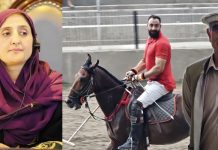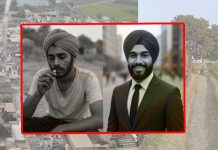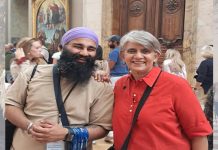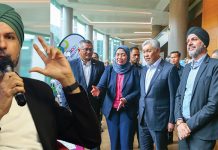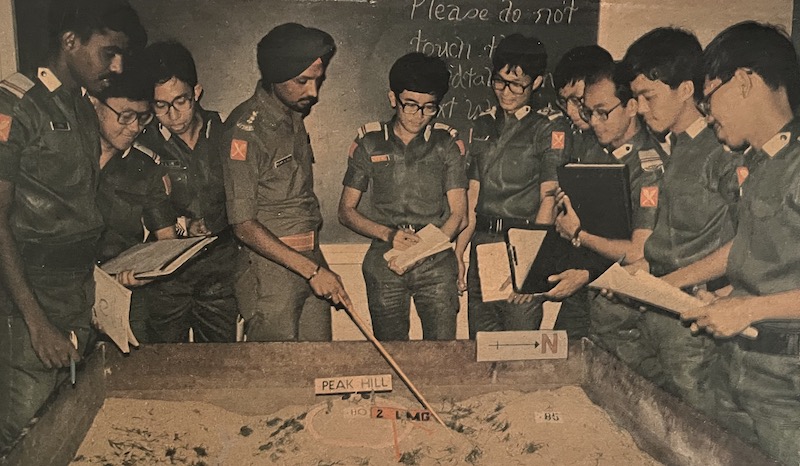
Mejar Singh Gill: Instructor at Officer Cadet School, Singapore Armed Forces Training Institute, 1982 – Photo: Supplied
BACKGROUND
Born in 1949, Mejar Singh Gill alias Major Singh Gill landed in Singapore as a 6 year old in 1955. He comes from a very humble family background. His father, without any formal educational background, came to Singapore in 1950 where he joined the British Naval Police Force as an ordinary Police Constable. Mejar grew up with his large family of 7 siblings in the Naval Base, among the large community of over 400 Sikh families then constituting the Naval Police Force. He was the third eldest in his family, with two sisters older than him. His father, being rather conservative and having plans then of eventually returning to Punjab, chose not to send his elder two daughters to school, being quite content with them mastering Gurmukhi and being proficient in the Guru Granth Sahib (Sikh Scripture) but quite happy to send Mejar to an English School, followed by other siblings later.
This was the period of significant changes in the region, and Singapore in particular, which impacted everyone’s life including Mejar’s.
“I did my initial primary education at the Admiralty Asian School within the Naval Base where we sang British National Anthem ‘God save the Queen’ daily. With Singapore attaining self-government in 1959, we all got transferred to Naval Base School, a newly built school outside of the Naval Base. Our national anthem, Majulah Singapura replaced ‘God save the Queen’. Just 4 years later we were singing another national anthem, Negara Ku when Singapore merged with Malaysia in September 1963.
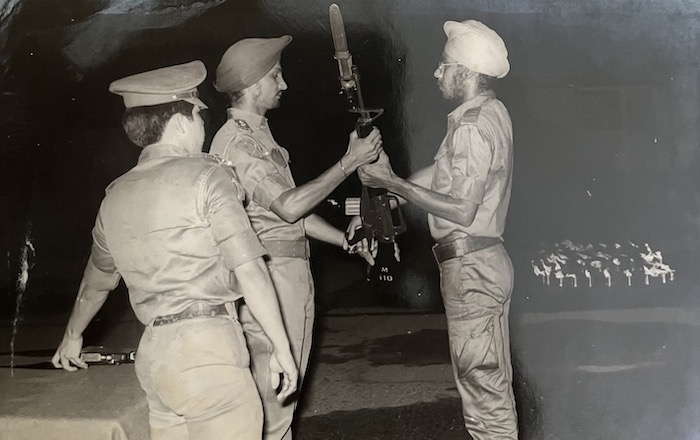
Mejar Singh Gill: Weapon presentation ceremony for recruits, 1974 – Source: Supplied
“What seemed to be interesting times, soon changed into turbulent times. Singapore’s merger with Malaysia was fraught with difficulties both within and from outside. Not only did Indonesia announce its policy of Konfrontasi (Confrontation) against Malaysia, there were also the racial riots of 1964. Not long after, we woke up on the morning of 9 Aug 1965 to see our Prime Minister Lee Kuan Yew emotionally announcing the separation of Singapore from Malaysia to become sovereign nation, and we all reverted to singing Majulah Singapura all over again.”
Immediately after obtaining his Senior Cambridge Certificate, and given his family’s financial situation with the younger siblings already going to school, Mejar applied for and got selected as a trainee teacher. He taught at West Hill Primary School in the morning session and attended classes at the Teachers’ Training College at Patterson Road for three afternoons a week, as was the arrangement those days.
But the ongoing developments in the region in the 1960s were to further change Mejar’s life. Instead of pursuing a teaching career, he soon found himself serving in the Armed Forces instead. Other than the Indonesian Confrontation, the Vietnam War was still raging and there were fears of the ‘domino effect’ on the non-communist states, including tiny Singapore. Hence, the emphasis on defence and the reliance on a conscript army rather than a regular army to defend Singapore.
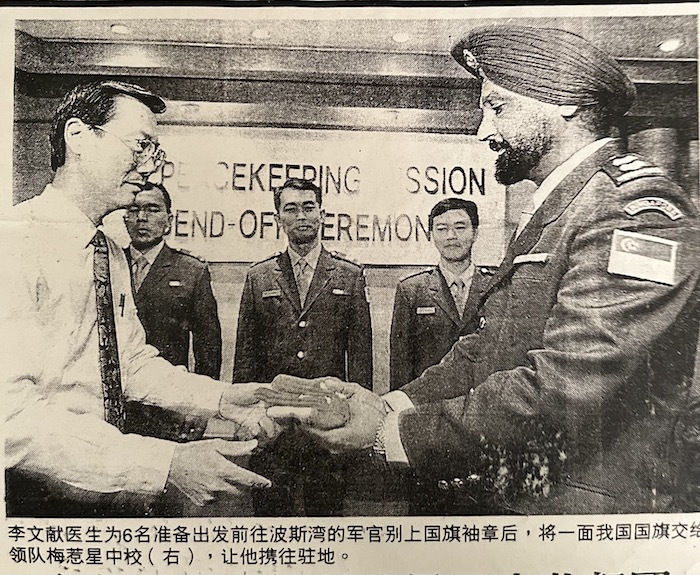
Mejar Singh Gill receiving the state flag from Singapore defence minister for UNIKOM Mission, 1995 – Photo: Supplied (Chinese newspaper cutting)
CALL UP TO SERVE
The first inkling of conscription being introduced in Singapore came in November 1966 when the Government announced that all newly appointed government and statutory board officers, subject to physical fitness, would have to do a stint of full time national service.
“When I became a trainee teacher, I was already anticipating being called for some form of military training but did not know where, when and how I will be involved. Things moved rather fast in 1967 when new legislation was tabled to amend the National Service Ordinance (which had originally been passed by the British in 1952),” he said.
On 21 Feb 1967 (which coincidently was his 18th birthday), PM Lee made the announcement of the introduction of national service, and in March 1967 the National Service (Amendment) Bill was formally passed in parliament. Soon after, small select groups of civil servants as well as students of institutions of higher learning under 30 years of age started receiving call up notices. A few days later, Mejar was one of over 9,000 18-year-old Singaporeans who received the enlistment notices, or pink cards, instructing us to register for NS at CMPB in Kallang.
“I did not just get one call-up notice but four! I happened to fall under all four categories of Singaporeans liable for national service during those early days of national service; namely young 18 years olds, new citizens, students of higher learning and new civil servants.
“In my case, I was 18 years old who had only recently become a naturalised citizen, was a new civil servant and was a student at Teachers Training College, which was then designated as an institution of higher learning. So even if I had tried to get deferment, which I had no desire to do so, there was little possibility for me succeeding as I fell into all four categories of persons liable for national service then,” he said.
On 9 Aug 1967, he proudly joined fellow Singaporeans in the republic’s second National Day Parade. The attention of all was on the marching uniform contingents, especially the one from SAFTI. Mejar was in the Teachers Training College Contingent. In subsequent years, after he enlisted into the Army on 21 Aug 1967, he too had a few opportunities to both participate in the participating contingents as well as be involved in some way or another in the organisational set up of the National Day Parades.
During his 30 years in the army, Mejar held various command, staff and instructional posts. In addition to commanding a Reserve Battalion, he also served in key staff roles at division level as well as in the Ministry of Defence (MINDEF). At the instructional level, he commanded companies training non-commissioned officers (NCOs) as well as Officer Cadets. His last post was that of Directing Staff at the Singapore Command and Staff College.
During his stint in the Army, he had the opportunity to train in several countries. In particular, he specialised in jungle training, where he underwent training at the renowned British Jungle Warfare School in Ulu Tiram, Malaysia; the Counter Insurgency & Jungle Warfare School (CIJWS) in Vairengte, Assam, India, as well as in the jungles of Brunei, Thailand and Taiwan. He also underwent various other forms of training in other countries such as Hawaii, US as well as Australia and New Zealand as well as participated in joint exercises with foreign armies.
Singapore, despite its small size, has played a very active role as a responsible member of the United Nations (UN). It has contributed in various fields, including humanitarian missions and peacekeeping operations. Mejar headed one such mission during his military career, which left him with ‘great memories being involved in such a noble cause’. He led the 5th SAF UNIKOM Team overseeing peacekeeping at the Kuwait/Iraq border.
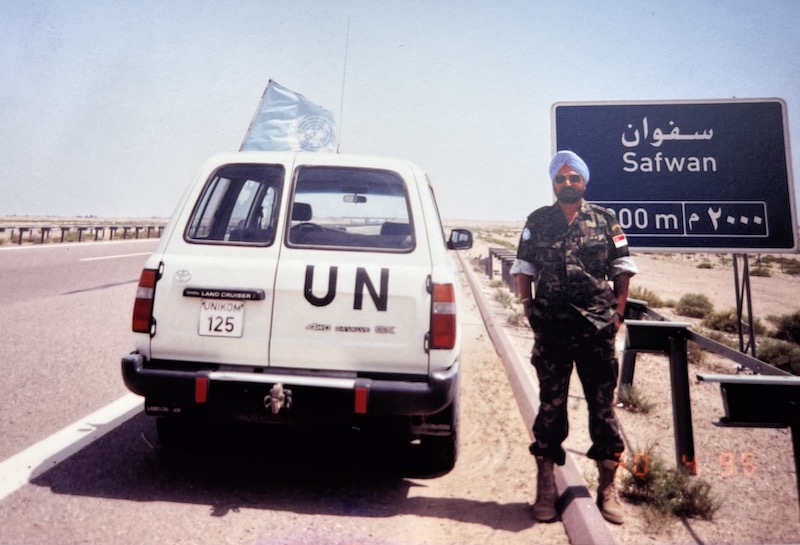
Mejar Singh Gill: Serving at Kuwait/Iraqi Border under the UN Peacekeeping Mission, 1995 – Source: Supplied
During his 30 years of service in the SAF, Mejar said that stands out as one of the most meaningful and insightful assignments he had undertaken in his military career. His greatest satisfaction was the opportunity to visit the Baba Nanak Shrine (also referred to as Tomb of Bahlol among the Arabs) in Karkh District of Baghdad which was still intact then.
Mejar joined the SAF with “O” levels but was fortunate that it gave him the opportunity to upgrade himself with a tertiary education. While serving the SAF, he did his “A” levels on a part-time basis and was awarded a scholarship to pursue studies at National University of Singapore (NUS) where he obtained a BA (Hons) in 1986.
After serving 30 years in the SAF and having attained the rank of Lieutenant Colonel, he decided to retire prematurely at the age of 47 at the end of 1996, when he joined the Ministry of Foreign Affairs (MFA).
DIPLOMATIC SERVICE
His second career lasted another 22 years. At MFA, his first new job was as Deputy Director, Consular Directorate, which required him to handle consular matters, including contingency planning. Given his military experience, for the first few years, despite having left the SAF, he found himself working hand-in-hand with SAF counterparts in planning and executing various operations that MFA undertook in assisting Singaporeans in distress overseas, namely the evacuation of Singaporeans from Cambodia and the Silkair Crash in 1997 followed by the assisted departure of Singaporeans from Indonesia during the 1998 riots in Indonesia.
Evacuation of Singaporeans from Cambodia in 1997. Barely 6 months after joining MFA, he was involved in working with MINDEF in executing the evacuation of over 450 Singaporeans from Cambodia whose safety was threatened by the Jun 1997 coup d’état and resultant civil war. The contingency plan in place was to pull out the Singaporeans, i.e. an “assisted departure” plan entailing use of commercial flights if civilian airport was operational and an “evacuation” plan through use of military aircraft if airport closed to civilian aircrafts. As the situation worsened, with clashes also taking place near the airport, the military option had to be activated. He represented MFA in coordinating the plan with MINDEF officials, which resulted in a successful operation involving 6 flights of C-130 aircraft with small groups of commandos on board.
Silkair Crash. Barely six months after the Cambodian Crisis, Mejar was back in action interacting with the SAF during the Silkair crash. Silkair MI 185, a scheduled Boeing 737-300 flight from Jakarta to Singapore plummeted into Musi River near Palembang in Southern Sumatra on 19 Dec 1997. There were 97 passengers of various nationalities and 7 crew members on board. He describes it as “a heart-breaking scene at the airport with friends and relatives trying to get information about the aircraft that had going missing.” With the SIA Crisis Management Group taking the lead, he led the MFA Contingency to assist in liaison on the ground with the Indonesian authorities. Unfortunately, no bodies were recovered from the scene. But it was a trying period spending time with the families in Palembang, desperate for news of their beloved ones.
1998 Riots in Indonesia. The fall of President Suharto in May 1998 resulted in serious civil disorder and unrest that warranted the safe evacuation of Singaporeans. Mejar was again involved in assisting in the planning and execution of the “assisted departure” of thousands of Singaporeans from Indonesia to Singapore. He remembers the chaotic scenes at Jakarta Airport with families of all nationalities desperate to get out.
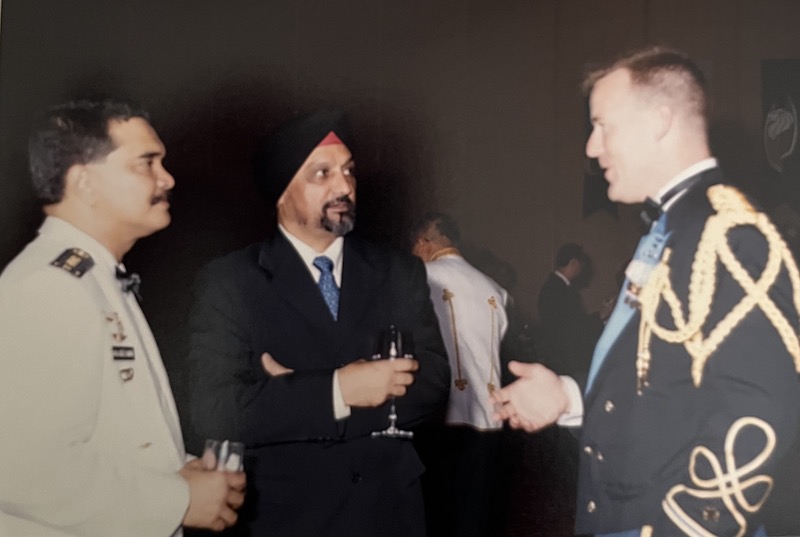
Mejar Singh Gill: Interacting with foreign military officers abroad, 2000 – Source: Supplied
OVERSEAS MISSIONS
Having served at the MFA HQ, the rest of his career entailed doing stints at overseas missions, namely in Indonesia, United States and India. To him, these were interesting times, where he had the opportunity to interact with the officials of the various countries in representing Singapore’s interests as well as interacting with foreign diplomats and the larger communities, including Singaporeans living there. The postings also provided him the opportunity of making many more friends as well as exploring the beautiful countries. But there were also occasions where he was again involved in assisting in several contingencies, including the 2004 Tsunami in Indonesia and the Nepal Earthquake in 2015.
The massive underwater earthquake of 26 Dec 2004, measuring 9.0 on the Richter scale, that stuck off the western coast of Sumatra, Indonesia, triggering several tsunamis which wrecked destruction in countries bordering the Indian Ocean, is one event etched in his memory. He was then serving at the Singapore High Commission in Jakarta and was at the scene for over two weeks where he saw hundreds of bodies and the mass graves dug as burial grounds.
“When the Tsunami took place, I was actually in Medan, about 400 km down south of Aceh, where I was attending a wedding of an Indonesian friend’s son. The hotel that we stayed in started shaking around 8 am in the morning. Though it did cause some alarm, with water spilling out of the swimming pool, the hotel management’s checks showed that there was no structural damage and we moved back to hotel after the short evacuation carried out,” he said.
Little did they realise the extent of the calamity befalling the people of Aceh around the same time that day. In the evening, he returned to Jakarta but was instructed to return back to Medan the next morning when the extent of the disaster become more apparent. From then onwards, it was a busy period for him and the Defence Attaché’s staff onsite coordinating with its Embassy Staff, MINDEF and other Indonesian agencies in rendering the necessary assistance.
Nepal Earthquake. During his posting in India, he was again involved in assisting Singaporeans in distress who found themselves stuck in Nepal during the massive earthquake that took place there in April 2015. This is because Singapore High Commission in India is also accredited to Nepal and Bhutan, and hence Mejar’s involvement. It was another trying experience.
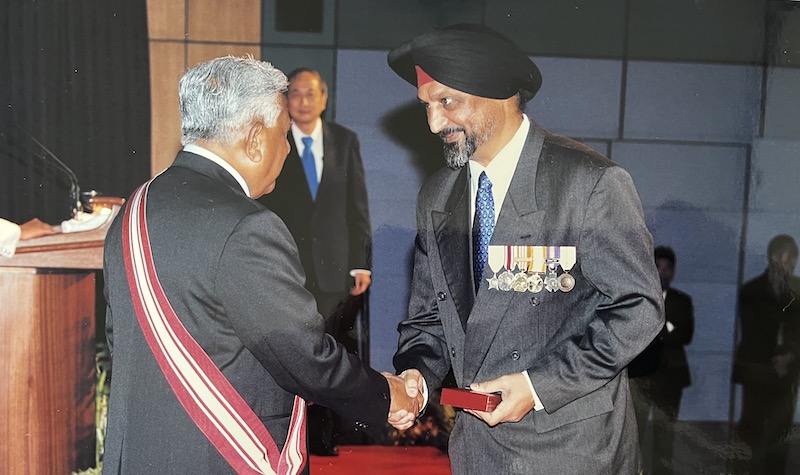
Mejar Singh Gill: Receiving National Day Award from President S R Nathan, 2005
SPORTS AND COMMUNITY
Mejar was an active sportsman in his schooling and army days, representing the Combined Schools and Singapore Armed Forces in hockey as well as playing for Singapore Khalsa Association (SKA). He was Singapore Armed Forces Hockey Convenor and also served as SKA’s vice president as well as vice president of Malaysia Singapore Sikh Sports Council (MSSSC). He is a serving trustee of SKA.
He has also been actively involved in community service. He was the founder member of Singapore Anti-Narcotics Association – Sikh Counselling Service in the mid-1970s, where he also served as chairman for several years. He is today actively involved at Gurdwara Sahib Yishun in Singapore.
In the course of his 52 years of service in the Singapore Armed Forces (SAF) and the MOF, LTC Mejar Singh Gill has won several commendation awards and citations, in addition to the UN (UNIKOM) Medal, SAF Overseas Service Medal and the National Day Long Service Medal and the Public Administration Medal.
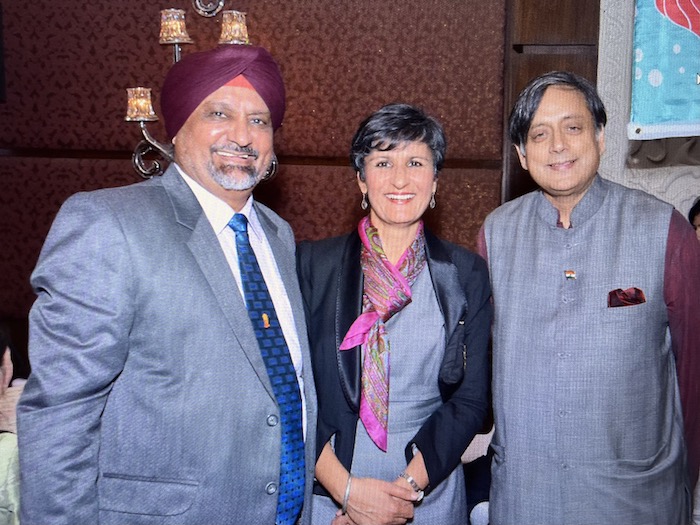
Mejar Singh Gill: With High Commissioner of Australia to India Harinder Sidhu (daughter of Ajaib Singh also previously from Naval Base Singapore) and former international diplomat, politician and writer Sashi Taroor, 2017
INTERESTING ANECDOTES
Name Confusion. For some reason or other, my father gave me a lower ranking order name, i.e. Mejar (spelled as Major in my identity card), while he named one sister of mine as Karnail and another as Jarnail (Punjabi pronunciations for Colonel and General!). This understandably caused much confusion when he served in both the SAF as well as MFA.
“For example, I went through several ranks, such as Corporal, 2nd Lieutenant, Lieutenant, Captain, Major and Lieutenant Colonel and most people got confused as to what my rank actually was. In my overseas diplomatic assignments too, when I introduced myself by name, some took me as an Army Officer serving in the Defence Attaché Office instead of as a diplomat,” he said.
He recollected a visit by a Malaysian Staff College delegation to his division, when one of the visiting Malaysian officers asked why he was wearing a name tag showing his rank while others were not. His name tag showed Mejar, the Malay spelling for major rank!
“There was another occasion when I once was pulled over in Johore by a Malaysian traffic policeman for a minor infringement. When he saw my name as Mejar, he asked if I was “Askar” and when I responded in the positive, he let me off,” he said.
RELATED STORY:
Rising Sikh star in Malaysian army (Asia Samachar, 30 April 2021)
ASIA SAMACHAR is an online newspaper for Sikhs / Punjabis in Southeast Asia and beyond.Facebook | WhatsApp +6017-335-1399 | Email: editor@asiasamachar.com | Twitter | Instagram | Obituary announcements, click here









